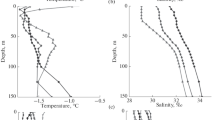Abstract
A hydrothermodynamic model of a multilayer ocean, incorporating the upper mixed layer (UML) is described. The model is based on a system of primitive equations integrated within each layer. All layers are assumed to be horizontally-inhomogeneous, however, the density in each thermocline layer changes within the limits determineda priori by the prescribed basic stratification. It is assumed that the layers may outcrop. Results of the numerical experiment on subduction simulation (downwelling of UML waters toward the main thermocline layers) are given.
Similar content being viewed by others
References
Schopf, P. S. and Cane, M. A., On equatorial dynamics mixed layer physics and sea surface temperature.J. Phys. Oceanogr. (1983),13, 917–935.
Huang, R. X. and Bryan, K. A multilayer model of the thermohaline and wind-driven ocean circulation.J. Phys. Oceanogr. (1987)17, 1909–1924.
Kraus, E. B., Bleck, R. and Hanson, H. P. The inclusion of a surface mixed layer in a large-scale circulation model. In:Small-Scale Turbulence and Mixing in the Ocean. Nihoul, J. C. J. (Ed.) Elsevier (1988) pp. 51–62.
Bleck, R., Hanson, H. P., Hu, D., and Kraus, E. B. Mixed layer-thermocline interaction in a three-dimensional isopycnic coordinate model.J. Phys. Oceanogr. (1989)19, 1417–1439.
Gent, P. R. and Cane, M. A. A reduced gravity primitive equation model of the upper equatorial ocean.J. Comput. Phys. (1989)81, 444–480.
Bryan, K. A numerical method for the study of the circulation of the World ocean.J. Comput. Phys. (1969)3, 347–376.
Mikhailova, E.N. and Shapiro, N.B. Modelling of the upper mixed layer in the tropical Atlantic.Sov. J. Phys. Oceanogr. (1991)2, 1.
Zilitinkevich, S. S., Resnyansky, Yu. D. and Chalikov, D. V. Theoretical modelling of the ocean upper layer.Itogi Nauki Tekh., Mekh. Zhidk. Gaza (1978)12, 5–51.
Niiler, P. P. and Krauss, E. B. One-dimensional models for the upper ocean layer. In:Modelling and Prediction of Upper Ocean Layers. Leningrad: Gidrometeoizdat (1979) pp. 175–208.
Mikhailova, E. N. and Shapiro, N. B. Modelling of the tropical Atlantic ocean active layer with application of quasimonotonic numerical schemes. Sevastopol (1988), (Preprint, MHI, Ukr. Ac. Sci.).
Samarsky, A. A. and Nikolaev, E. S.Methods for Resolving Grid Equations. Moscow: Nauka (1978).
Additional information
Translated by V. Puchkin.
Rights and permissions
About this article
Cite this article
Mikhailova, E.N., Shapiro, N.B. Quasi-isopycnic layer model for large-scale ocean circulation. Phys. Oceanogr. 4, 251–261 (1993). https://doi.org/10.1007/BF02197624
Issue Date:
DOI: https://doi.org/10.1007/BF02197624




